The Parish of Llanedi is situated on the River Loughor, near the county border with Glamorgan. The men of the parish who fell during both world wars are commemorated on a war memorial which is located at St. Edith’s Churchyard. Several men from the nearby towns of Hendy and Pontarddulais are commemorated on the Llanedi War Memorial. I have also taken the opportunity to add the details of several men from the parish who are not named on the memorial, the photograph of which was kindly sent in by Nigel Richards.
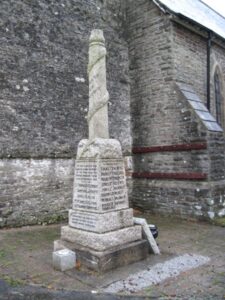
The Great War, 1914-1918
Idris Anthony, Private, 12897, Royal Welsh Fusiliers. Idris was the son of John and Jane Anthony, of Heulwen Villa, Tycroes. He enlisted at Ammanford into the 10th Battalion, Royal Welsh Fusiliers. The battalion was attached to 76 Brigade, 25th Division, and landed in France on 27 September 1915, with 76 Brigade moving to the 3rd Division within weeks. By the summer of 1916 the Division was on the Somme, and took part in the Battle of Guillemont. Idris was killed in action here on 16 August 1916, aged 21. He has no known grave, and is commemorated on Pier and Face 4A of the Thiepval Memorial, France.
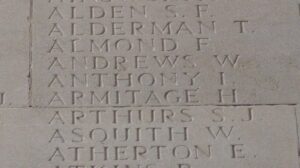
William Robert Bridges, Second Lieutenant, Bedfordshire Regiment. William was born at Llanedi on 30 July 1894, the son of Philip and Mary Bridges (nee Williams), the daughter of Reverend Roger Williams, Rector of Llanedi. The family moved to Holm Place, Stonehouse, Gloucester, at some time after 1911, and William was educated at Shrewsbury School. After the outbreak of war he enlisted into the 19th Battalion, Royal Fusiliers, and served in France until 14 January 1915. William was commissioned in August 1916 as Second Lieutenant into the 4th Battalion, Bedfordshire Regiment, which was in France attached to 190 Brigade, 63rd (Royal Naval) Division. William saw heavy fighting at Beaumont Hamel during the winter of 1916, and was wounded there on 13 November, before returning home to recover. Early in 1917, he rejoined his battalion at Arras, where he was badly wounded during the assault on Gavrelle on 23 April 1917. William was brought back to the Casualty Clearing Station at Aubigny, where he died of his wounds that day. He was 22 years old, and is buried at Aubigny Communal Cemetery Extension, France. William is not commemorated locally.
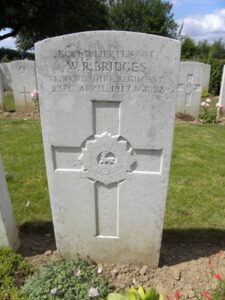
Ernest William Burridge. Private, 265775, Welsh Regiment. Ernest was the son of Samuel Joseph and Emily Annie Burridge of Crediton, Devon. He was living with his brother Charles at Pontarddulais prior to the war and married Lydia Alice Maud Chandler, of 1, Wernbwll, Hendy in the summer of 1911. Ernest worked as a Tinsman, and enlisted at Swansea into the 6th Battalion, Welsh Regiment, which was a Territorial Battalion. The battalion had been in France since October 1914, and was then attached to the 1st Division as Pioneers from October 1915. They then fought during the action at the Hohenzollern redoubt, at Loos. In 1916 the Division moved south to the Somme, where they fought during the opening of the Somme Offensive at the Battle of Albert, and then at Bazentin, Pozieres, Flers-Courcelette and Morval. They followed the German retreat to the Hindenburg Line in early 1917, and were then briefed for an operation on the Flanders Coast, and moved there during the summer of 1917. While training on the coast, the Battle of Third Ypres had stalled in the mire, and the Division were recalled to Ypres, where they fought at the Second Battle of Passchendaele. Ernest was wounded at Passchendaele, and died of his wounds on 27 October 1917. He was 29 years old, and is buried at Dozinghem Military Cemetery, Belgium, in Grave XII. C. 4. Ernest is shown amongst the Llanedi men on the County War Memorial Roll, but is not named on the local Memorial.
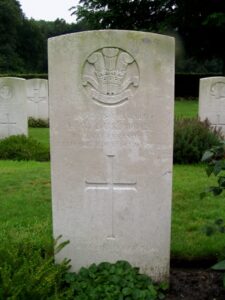
William Gordon David, Private, 36364, Welsh Regiment. William was the son of John and Mary Jane David, of 54, Bryn Road, Llanelli. He enlisted there into the South Wales Borderers, and later transferred into the 1st Battalion, Welsh Regiment, which was attached to 84 Brigade, 28th Division. The Division formed in England between December 1914 and January 1915 from regular units returning from India, Singapore and Egypt. During January 1915 it moved to France, landing at Le Havre and moved to the Western Front, where it saw its first major action during the Second Battle of Ypres. Following serious casualties at Ypres, a Composite Brigade was formed, composing of the 2nd Battalion, the Buffs, 2nd Battalion, the Cheshires, 1st Battalion, the Welsh, and 1st Battalion, the York and Lancaster. It was dissolved on 19 May 1915, and the formation assumed its normal configuration, taking part in the Battle of Loos. William was killed at Loos on 2 October 1915, aged 27. He is commemorated on Panel 77/78 of the Loos Memorial, France. William is shown amongst the Llanedi men on the County War Memorial Roll, but is not named on the local Memorial.
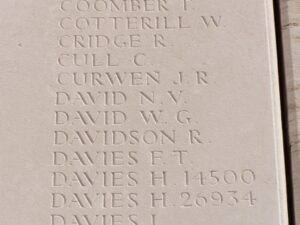
Arthur Thomas Davies, Able Seaman, Z/3581, Royal Navy. Arthur was born at Llandingat on 19 June 1897, the son of John and Gwladys Davies. By 1901 the family had moved to 3, River Terrace, Llanedi, and at some time later moved again to Brynhyfryd House, Wernbwll Road, Hendy. Arthur served in the Royal Navy, aboard the cargo steamer SS Bristol City. On 16 December 1917 the Bristol City was on voyage from Bristol to New York when she was sunk by the German submarine U-94, with the loss of 30 lives. Arthur was just 20 years old when he died that day, and is commemorated on Panel 24 of the Plymouth Naval Memorial, Devon.
John Edgar Davies, Private, 15250, Connaught Rangers. John was the eldest son of William and Margaret Davies, of 5, Penallt Terrace, Llanelly. He enlisted at Marylebone into the Wiltshire Regiment, and served at Gallipoli before transferring to the 5th Battalion, Connaught Rangers, which was attached to 197 Brigade, 66th (2nd East Lancs) Division. The Division concentrated on the Western Front in March 1917 and moved to the Flanders Coast. At the end of September 1917 they moved to Ypres, and took part in the Battle of Poelcapelle. They then moved south to the Somme, and on 21 March 1918 were hit by the German Spring Offensive at the Battle of St Quentin, and moving back west fought at the Actions at the Somme Crossings, and the Battle of Rosieres. After suffering very heavy casualties during the Battles of the Somme in 1918, the Division was first reduced to a training cadre and then reformed and reconstituted, before taking part in the final offensive, fighting at the Battle of Cambrai, and the Pursuit to the Selle and the Battle of the Selle. John was wounded during the final days of the war, and died on 8 November 1918, aged 22. He is buried at Pont-Sur-Sambre Communal Cemetery, France, in Grave B.21. John is shown amongst the Llanedi men on the County War Memorial Roll, but is not named on the local Memorial.
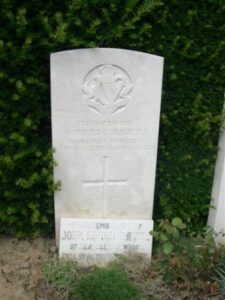
Thomas Haydn Davies, MM, Private, 20732, Welsh Regiment. Thomas was the son of Thomas and Elizabeth Davies, of 6, Quarry Row, Pantyffynon. He enlisted at Pontarddulais into the 15th Battalion, Welsh Regiment, the ‘Carmarthen Pals’. The Battalion was part of 114 Brigade, 38th (Welsh) Division, which had landed in France during December 1915 and had spent their first winter in the trenches near Armentieres. In June they marched south to the Somme, where they were tasked with the capture of Mametz Wood. The attack on the wood began on 7 July, but met with fierce resistance, and it took until 14 July to finally clear the wood. The Division suffered terrible casualties at Mametz, and were taken out of the line, and moved to Ypres to rebuild. Thomas was killed in action at Ypres on 30 January 1917. He is buried at Bard Cottage Cemetery, Belgium. Thomas had been awarded the Military Medal for bravery during his twelve months on the front, probably for action at Mametz Wood.
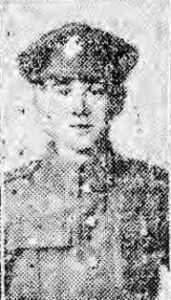
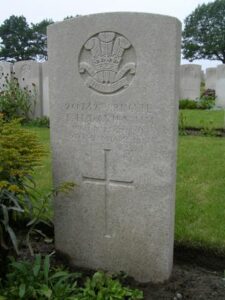
David John Evans, Private, 220, Welsh Guards. David was the son of David and Anne Evans, of 1, Sawel Terrace, Llanedi, and later of 7, Harleyford Road, Hendy. He served with the Glamorgan Constabulary prior to the war, before enlisting at Llanelli into the Grenadier Guards. David then transferred to the newly formed Welsh Guards early in 1915. The Welsh Guards were then attached to 3 Guards Brigade, Guards Division, which was formed in France in August 1915, and saw its first major action during the Battle of Loos on 25 September 1915. During the coming months they also fought in the subsequent Action of Hohenzollern Redoubt. In July, 1916 the Division moved to the Somme, where they fought at the Battle of Flers-Courcelette, and then at the Battle of Morval, capturing Lesboeufs Village. They remained here for the winter, and in March, 1917 took part in the advance caused by the German Retreat to the Hindenburg Line. Later that year they moved north to Ypres, where they fought at the Battle of the Pilkem. David was killed here on 31 July 1917. He was 24 years old, and is buried at Duhallow A.D.S. Cemetery, Belgium. His brother, Trevor Lewis Evans, also fell.
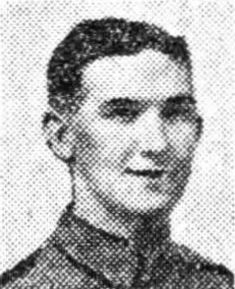
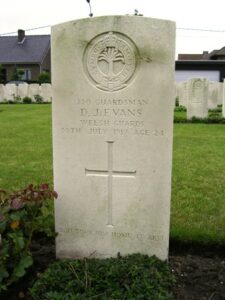
Trevor Lewis Evans, Trooper, 3412, Household Cavalry. Trevor was probably the son of David and Ann Evans, of 1, Sawel Terrace, Llanedi. He enlisted at Llanelli into the 1st Life Guards, Household Cavalry. On 7 October 1914 they landed at Zeebrugge attached to the 3rd Cavalry Division. Other than in the first two weeks when it was used in the traditional cavalry, for mobile reconnaissance, it fought most of the war as a dismounted force, and saw action at First Ypres, Second Ypres, Loos and Arras. For most of the time, it took its turn in holding various sections of the front, while remaining prepared to exploit breakthroughs in battle, but opportunities rarely presented themselves. Trevor was killed near the Hindenburg Line on 7 February 1918, aged 22. He was buried at Tincourt New British Cemetery, France.
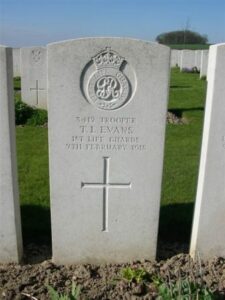
Herbert Roye Goldsby, MM, Sergeant, 12854, Royal Welsh Fusiliers. Herbert was born on 16 August 1886, the son of Edwin and Elizabeth Goldsby, of Paddington, London. He had moved to West Wales by 1911, working as a coal hauler at Llandebie, before moving to Llanedi. He enlisted at Tumble into the 9th Battalion, Royal Welsh Fusiliers, who were attached to 58 Brigade, 19th (Western) Division. The Division assembled around Bulford during September 1914. Divisional training was completed near Tidworth, from March 1915, and the Division crossed to France between 11 and 21 July 1915, and moved to positions near Loos. The Division fought during the opening attack of the Battle of Loos, and then moved to the Somme, where they took part in the second wave of the attack on Ovillers-La Boiselle on the 1st July, capturing the village at heavy cost, and fought through the Somme Battle of Pozieres, where Herbert was killed in action on 27 July 1916. He was 28 years old, and is remembered on the Thiepval Memorial, France. Herbert had won the Military Medal for Bravery, and as it was a relatively new award at that time, it must have been for the attack on Ovillers.
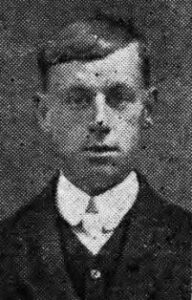
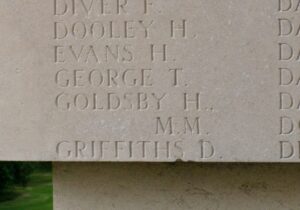
Joseph Harrop Griffiths, Second Engineer, Mercantile Marine. Joseph was the son of David Griffiths and Charlotte Griffiths (nee Harrop), of Brondeg, Pontardulais. He was a steam engine builder at Bolton prior to the war and enlisted into the Mercantile Marine. Joseph was posted aboard the SS Daybreak, a West Hartlepool registered ship. On 24 December 1917 Daybreak was on voyage carrying a cargo of maize when she was sunk by a torpedo which had been fired without warning by a German submarine, near South Rock Lightship, Strangford Lough, Co Down. The entire crew were lost. Joseph was 23 years old, and is commemorated alongside his shipmates on the Tower Hill Memorial, London.
William Hewitt, Stoker 1st Class, SS/110923, Royal Navy. William was born on 23 March 1890, the son of David and Rachel Hewitt, of Voylart Road, Dunvant, Swansea. His parents were from Llanedi, but had lived at Dunvant for several years. William joined the Royal Navy, and was posted aboard the armoured cruiser H.M.S. Defence. On 31 May 1916 Defence was forming part of the protective escort to the Grand Fleet when it engaged the German High Seas Fleet at the Battle of Jutland. While attacking a disabled German cruiser, Defence was struck by salvoes from a German battlecruiser and four dreadnoughts, and blew up with the loss of all her crew of around 900 men. William was 26 years old, and is commemorated along with his former crew on the Plymouth Naval Memorial, Devon.
Thomas Hughes, Private, 12874, Devonshire Regiment. Tom was the son of Thomas and Frances Hughes, of Myrtle House, Mynyddllno, Pontarddulais. He worked as a coal haulier prior to the war and enlisted at Swansea into the 2nd Battalion, Devonshire Regiment. The battalion had landed in France on 6 November 1914, attached to 23 Brigade, 8th Division. They saw their first major action at the Battle of Neuve Chapelle, and it was there that Tom was killed on 13 March 1915. He was 22 years old, and is commemorated on the Le Touret Memorial, France.
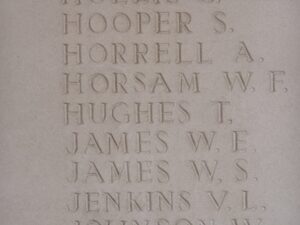
William Hughes, Private, 20750, Welsh Regiment. William was probably the son of Thomas and Hannah Hughes, of Sardis Cottage, Llanedi, Pontarddulais. He enlisted at Ammanford at the outbreak of war into the 15th Battalion, Welsh Regiment, known as the Carmarthen Pals. The battalion trained at Rhyl until the summer of 1915 when it moved to Winchester as part of 114 Brigade, 38th (Welsh) Division. In December 1915 the Division moved to France, where it took the line near Fleurbaix, where it was initiated into trench warfare. In June 1916, the Division moved to the Somme, where it captured Mametz Wood, before being posted to positions north of Ypres, where it remained until taking part in the Battle of Pilckem Ridge, and the Battle of Langemarck. William was killed here on 7 September 1917, aged 36. He has no known grave, and is commemorated on Panel 93-94 of the Tyne Cot Memorial, Belgium.
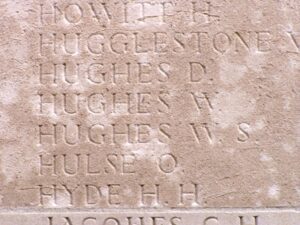
David Jones, Pioneer, 159329, Royal Engineers. David was born at Llanedi in 1894, the son of William and Mary Ann Jones. The family later resided at Pantycelyn, Tycroes, Pantyffynnon. David had originally enlisted at Bangor into the Royal West Kent Regiment, but was later posted to the 5th Battalion, Special Brigade, Royal Engineers. This was one of the Special (Gas) Companies, which had been formed as a chemical warfare unit, which deployed the poison gas cylinders which were used on the Western Front. David was wounded during the Battle of the Somme, and died of his wounds on 21 August 1916, aged 22. He is buried at Heilly Station Cemetery, Mericourt-L’Abbe, France, in Grave III. F. 44.
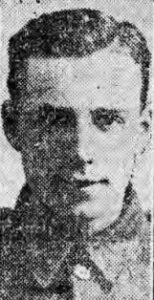
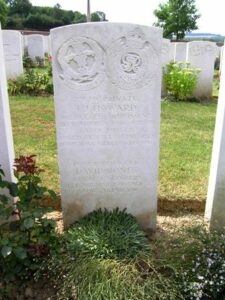
David Thomas Jones, Able Seaman, J/50063, Royal Navy. David was born at Blaengarw on 23 January 1892, the son of William and Elizabeth Jones. The family later resided at Llanedi before settling at Brynderi, Penybank. David served in the Royal Navy, aboard HMS Anchusa, which was a special service vessel, built to look like a merchant ship. David was killed when she was torpedoed off the north coast of Ireland on 16 July 1918, and sank with the loss of 79 men. David was 24 years old, and is commemorated on Panel 27 of the Plymouth Naval Memorial, Devon.
Griffith Elphin Jones, Cadet, Mercantile Marine. Griffith was born in 1901, the son of Reverend Griffith and Catherine Jones, of Capel Newydd, Hendy, Pontarddulais. He joined the Mercantile Marine as a Cadet, and served aboard the Elder-Dempster Line Steamship RMS Burutu. On 3 October 1918, Burutu was sailing through St. George’s Channel, on voyage from Lagos, W. Africa to Liverpool with a general cargo, and tin ingots. In poor conditions, she was struck midships by the Glasgow registered S.S. City of Calcutta, and sunk in minutes with the loss of 150 lives. Griffith was just 17 years old when he died that day, but because the ship was not a war loss, he is not commemorated by the Commonwealth War Graves Commission. His brother Richard also fell.
Latimer Jones, Private, 2041, Welsh Guards. Latimer was the son of William and Elizabeth Jones, of Goleufryn, Tycroes. He enlisted at Oswestry into the 1st Battalion, Welsh Guards, which had been formed during March 1915 by Royal Warrant, before moving to France, where it joined 3 Guards Brigade, Guards Division. It remained on the Western Front throughout the war and saw its first major action during the Battle of Loos on 25 September, 1915, remaining in the area during the coming months, where they also fought in the subsequent Action of Hohenzollern Redoubt. In July, 1916 the Division moved to the Somme, where they fought at the Battle of Flers-Courcelette, and then at the Battle of Morval, capturing Lesboeufs Village. They remained here for the winter, and it was here that Latimer was killed on 8 March 1917. He was 25 years old, and is buried at Sailly-Saillisel British Cemetery, France, in Grave II. J. 3.

Matthew George Jones, Trimmer, 2677ST, Royal Navy. Matthew was born on 24 February 1897, the son of Thomas and Elizabeth Jones, of Harddfan Harleyford Road, Hendy. He served in the Royal Navy, as one of two men from Llanedi, aboard HMPMS Ascot, the first Paddle Minesweeper to be built for the Royal Navy. On 10 November 1918 Ascot was on minesweeping duties off the Farne Islands when she was torpedoed and sunk by the German submarine UB67. Ascot became the last Royal Naval ship to be lost during the Great War. Matthew was 21 years old when he was killed during the sinking, and is commemorated on Panel 29 of the Plymouth Naval Memorial, Devon.
Richard Alun Jones, Second Lieutenant, Tank Corps. Richard was the son of Reverend Griffith and Catherine Jones, of Capel Newydd, Hendy. He initially volunteered to serve with the Montgomeryshire Yeomanry, before being commissioned on 6 March 1917 into the Heavy Branch, Machine Gun Corps. On 28 July 1917 the Heavy Branch was separated from the rest of the Machine Gun Corps to form the Tank Corps. The newly formed Corps saw action during the Battle of Passchendaele, where the tanks proved incapable of moving across the sodden ground. The tank would prove its worth towards the end of the year, when they were used en masse to break the Hindenburg Line, during the Battle of Cambrai. Richard was in command of Tank D41 ‘Demon II’, part of ‘D’ Battalion, Tank Corps. On 20 November 1917, ‘D’ Battalion was attacking toward Flesquières when a shell made a direct hit on D41, instantly killing all her crew. Richard was 20 years old, and was buried in Flesquières Hill British Cemetery, France, in Grave VIII. E. 10. His brother Griffith was lost at sea in 1918. The fascinating fact about this is that a Tank has recently been recovered off the Flesquières Battlefield, which was at first thought to be D41. The tank has since been identified as D47, and is now on display in Flesquières.
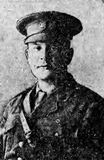
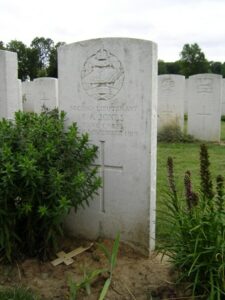
Albert Henry Malyon, Private, 14153, Royal Welsh Fusiliers. Albert was the son of Albert Edward and Sarah Malyon, of Peckham. By 1911 Albert was working in West Wales and at the outbreak of war enlisted at Llanelli into the 2nd Battalion, Royal Welsh Fusiliers. The battalion landed in France on 11 August 1914, and became attached to 19 Brigade, at Valenciennes. On 12 October 1914, 19 Brigade became attached to 6th Division, based at positions near Ypres. On 31 May 1915 the Brigade moved to 27th Division, then on 19 August 1915 moved to 2nd Division. The 2nd RWF then fought at the Battle of Loos, before joining 33rd Division. Albert was killed during the first week of the Somme Offensive, on 6 July 1916, aged 22. He is buried at Gorre British & Indian Cemetery, France, in Grave II. A. 19.
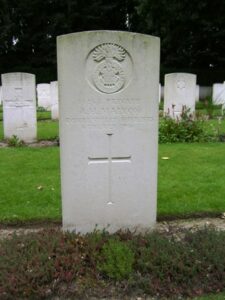
Samuel Nicholas, Private, 39913, Labour Corps. Samuel was the son of William and Ann Nicholas, of Llangennech. He resided with his wife, Lizzie Mary Nicholas, at 66, Pantyffynon Road, Ammanford prior to the war. Samuel enlisted at Ammanford into the 15th Battalion, Welsh Regiment, known as the Carmarthen Pals, but was later posted to the 7th Battalion, Royal Welsh Fusiliers. He must have been wounded at some time, as he was again transferred, joining the 911th Area Employment Company, Labour Corps. Samuel was wounded during the German Offensive of spring 1918, and died as a result of his wounds at St. Omer on 31 May 1918, aged 29. He is buried at Longuenesse (St. Omer) Souvenir Cemetery, France, in Grave V. B. 46.
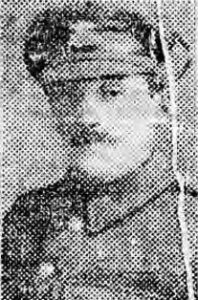
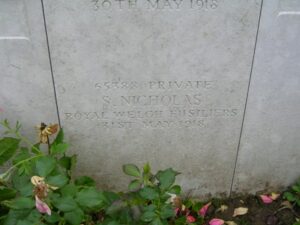
William Hordern Norris, Private. Hordern was born in Middlesex in 1899, the son of John Frederick and Sarah Norris. By 1901 he was residing with his Grandparents Joseph and Harriet Green, at 16, Gilbert Place, Llanelly. He is also commemorated on the Great Western Railway Memorial, and is listed as being based in the Engineering Department at Pantyffynon. He possibly died in West Ham in 1920, but is not commemorated by the Commonwealth War Graves Commission.
George Palmer, Driver, 92455, Royal Field Artillery. George was the son of William and Mary Palmer, of 1, Green Terrace, Hendy, and enlisted at Swansea into the Royal Field Artillery. He was posted to ‘B’ Battery, 69th Brigade, which was attached to the 13th (Western) Division. Towards the end of February the entire Division concentrated at Blackdown in Hampshire. On 7 June 1915 orders were received to prepare to move to the Mediterranean. On 13 June 1915 the first transports carrying the Division left port, and moved to Alexandria. By 4 July, all units had moved to Mudros, preparatory for landing on Gallipoli. Between 6 and 16 July 1915 the Divisional infantry landed on Cape Helles and relieved the 29th Division. George was killed soon after landing, on 26 July 1915. He was 20 years old, and is buried at Ari Burnu Cemetery, ANZAC, Gallipoli, in Grave G.13.
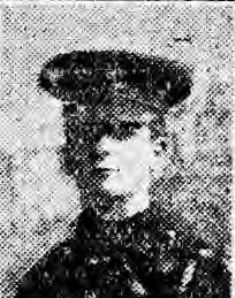
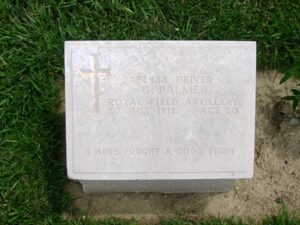
Thomas Henry Phillips, Gunner, 3187, Royal Field Artillery. Thomas was the son of William and Mary Phillips, of Bryngwili Road, Hendy. He married Annie Williams on 11 April 1914, and the couple had a son, William David Phillips. Thomas worked as a miner at the Graigola Colliery, and enlisted at Pontypridd into the Royal Field Artillery. He was posted to the 122nd Brigade, Royal Field Artillery, which was attached to the 38th (Welsh) Division. The Division had landed in France during December 1915 and had spent their first winter in the trenches near Armentieres. In June they marched south to the Somme, where they were tasked with the capture of Mametz Wood. The attack on the wood began on 7 July, but met with fierce resistance, and it took until 14 July to totally clear the wood. The Division suffered terrible casualties at Mametz, and were taken out of the line, and moved to Ypres to rebuild. Here they fought at the Battle of Pilckem Ridge, and it was here that Thomas was wounded during the opening day of the Battle, on 31 July 1917. He died later that day of his wounds, aged 23, and is buried at Dozinghem Military Cemetery, Belgium, in Grave II.H.16.
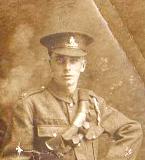
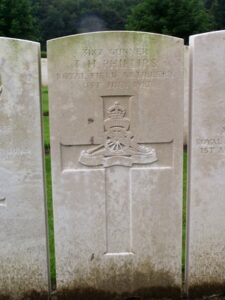
James Price, Trimmer, 2678ST, Royal Navy. James was born on 27 February 1897, the son of John and Eleanor Price, of Harleyford Road, Hendy. He served in the Royal Navy, as one of two men from Llanedi, aboard HMPMS Ascot, the first Paddle Minesweeper to be built for the Royal Navy. On 10 November 1918 Ascot was on minesweeping duties off the Farne Islands when she was torpedoed and sunk by the German submarine UB67. Ascot became the last Royal Naval ship to be lost during the Great War. James was 21 years old when he died during the sinking, and is commemorated on Panel 29 of the Plymouth Naval Memorial, Devon.
John Price, Private, 21042, Welsh Regiment. John was the son of James and Mary Ann Price, of 23, West Cottage, Brockhampton, Herefordshire. He was a Tinworker at Pantyffynon prior to the war, and enlisted at Ammanford on 25 May 1915 into the 15th Battalion, Welsh Regiment, which was known as the Carmarthen Pals. The battalion trained at Rhyl until the summer of 1915 when it moved to Winchester as part of 114 Brigade, 38th (Welsh) Division. In December 1915 the Division moved to France, where it took the line near Fleurbaix, where it was initiated into trench warfare. In June 1916, the Division moved to the Somme, where it launched its assault against Mametz Wood on 7 July. This first assault failed, and on 10 July the division made its second attack, capturing the wood after days of hand to hand fighting. John was killed in action in the wood on 11 July 1916, aged 17, and is commemorated on Pier and Face 7A and 10A of the Thiepval Memorial, France.
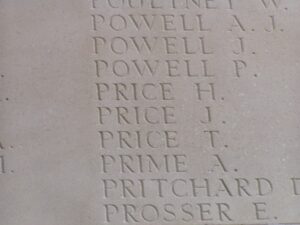
William Owen Rees, Gunner, 4796, Royal Field Artillery. William was the son of William and Sarah Rees, of Clusty, Cwm, Tycroes. He enlisted at Swansea into the Royal Field Artillery, and was posted to ‘C’ Battery, 122nd Brigade, which was attached to the 38th (Welsh) Division. The Division had landed in France during December 1915 and had spent their first winter in the trenches near Armentieres. In June they marched south to the Somme, where they were tasked with the capture of Mametz Wood. The attack on the wood began on 7 July, but met with fierce resistance, and it took until 14 July to totally clear the wood. The Division suffered terrible casualties at Mametz, and were taken out of the line, and moved to Ypres to rebuild. Here they fought at the Battle of Pilckem Ridge, and in the following Battle of Langemarck. William was wounded at Langemarck, and died of wounds on 11 August 1917, aged 22. He is buried at Mendinghem Military Cemetery, Belgium, in Grave IV. B. 48.
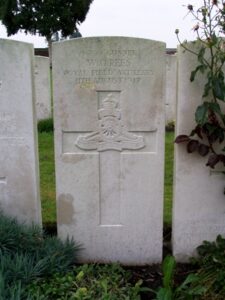
Richard Harry Sampson, Lieutenant, Welsh Regiment. Richard was the son of Richard Harry and Eliza Louisa Sampson, of Pontardulais. He was commissioned on 23 June 1915 and was posted to the 15th Battalion, Welsh Regiment on 23 July 1916, joining the battalion after they had taken part in the attack on Mametz Wood, where it was attached to 114 Brigade, 38th (Welsh) Division. He then fought with the battalion during the following twelve months at Ypres, and saw action at Pilckem Ridge. On 26 February 1918 he was posted to the Headquarters Staff of the 38th Division, and sadly became ill during the final weeks of the war, dying of pneumonia at the Base Hospital at Étaples on 29 October 1918, aged 27. Richard is buried at Étaples Military Cemetery, France, in Grave XLVIII. C. 5.
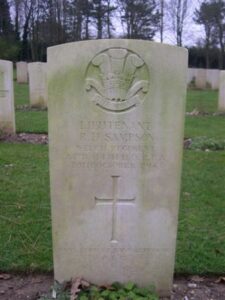
Frederick Terrington, DCM, Corporal, 13695, Royal Welsh Fusiliers. Fred was the son of John and Selina Terrington, of Llantrisant. His step-sister, Maria Salathiel, married Thomas Watkins, of Brynrhos Tycroes, Pantyffynon in 1898, and Fred looks to have been brought up by Maria. Fred had enlisted at Ogmore Vale into the 1st Battalion, Royal Welsh Fusiliers, which was attached to 22 Brigade, 7th Division. The Division had originally landed at Zeebrugge on 6 October 1914, before moving to Ypres. It fought at almost every major battle on the Western Front, before being moved to the Italian Front late in 1917. During the Battle of Passchendaele, before the move to Italy, Fred gained the honour of being awarded the Distinguished Conduct Medal for his gallantry, which was listed in the London Gazette of 28 March 1918. The citation read ‘For conspicuous gallantry and devotion to duty in volunteering three times to go on patrol. He drove in a small enemy covering party and accurately located two machineguns, though under heavy fire, in daylight. Later, he brought in many wounded, and though himself wounded, refused to withdraw until ordered to do so.’ Sadly, just two days later, on 30 March 1918, Fred was accidentally killed. He was 21 years old, and is buried at Padua Main Cemetery, Italy, in Grave B. 5.
David Cuthbert Thomas, Second Lieutenant, Royal Welsh Fusiliers. David was the son of Reverend Evan and Ethelinda Thomas, of Llanedi Rectory, Pontardulais. He was commissioned into the 3rd Battalion, Royal Welsh Fusiliers, and after training was posted to the 1st RWF, which was attached to 22 Brigade, 7th Division. By early 1916 the Division was in position at the Citadel, near Fricourt, on the Somme. On 18 March 1916, David was in charge of a working party, which was repairing wire emplacements in No Mans Land when he was shot in the throat. He walked to the First Aid Post for treatment, but began choking and died shortly afterwards. He was 20 years old, and is buried at Point 110 New Military Cemetery, Fricourt, France, in Grave D. 3. David was a close friend of the famed war poets, Siegfried Sassoon and Robert Graves, and his death left Siegfried especially very angry towards the Germans; an anger which led to his earning the Military Cross after a series of rash excursions into German territory. Robert Graves wrote a poem in memory of David, entitled ‘Not Dead’, and David is mentioned in several poems and biographies written by both men, under the pseudonym of Dick Tiltwood in one. It was largely David’s death that famously soured Sassoon’s attitude towards the war.
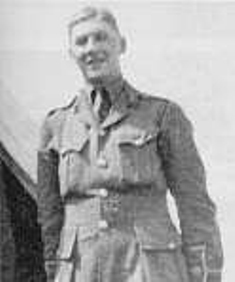
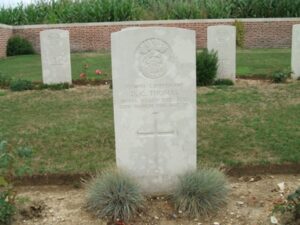
W. J. Thomas, Private, Welsh Regiment. This man cannot presently be identified.
Daniel Watkins, Able Seaman, Z/1793, Royal Navy. Daniel was born on 15 June 1890, the son of John and Catherine Watkins, of Bryntirion, Tycroes, Pantyffynnon. He served in the Royal Navy, aboard the Battlecruiser HMS Black Prince, which was attached to the First Cruiser Squadron. Black Prince took part in the Battle of Jutland on 31 May 1916, and survived the initial encounter with the German High Seas Fleet. When darkness fell, Black Prince strayed into the German lines, and was immediately showered with salvoes from around five German ships, and sank with the loss of all of her crew of 857 men. Daniel was 26 years old when he died on 31 May 1916, and is commemorated on Panel 19 of the Plymouth Naval Memorial, Devon.
David Watkins, Private, 119247, Machine Gun Corps. David was the son of Mary Ann Watkins, of Glebeland Cottage, Tycroes, Pantyffynnon. He initially enlisted at Merthyr into the Welsh Regiment, but was transferred to the 121st Company, Machine Gun Corps, which was attached to 121 Brigade, 40th (Bantam) Division. The division moved to France in 1916, and moved to the Loos sector, before taking part in the latter stages of the Somme offensive. In 1917 it saw action during the German retreat to the Hindenburg Line, and later that year took part in the Battle of Cambrai, famously capturing Bourlon Wood in November. David survived the terrible fighting there, but died on 31 December 1917, aged 20. He is buried at Bucquoy Road Cemetery, Ficheux, France, in Grave Ref. II. G. 14.
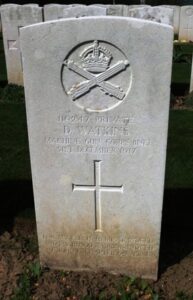
Ivor Carlyle Williams, Private, 66193, Cheshire Regiment. Ivor had been born at Milford Haven, the son of John and Eleanor Williams. By 1911 the family had moved to 11, William’s Street, Pontardulais. Ivor enlisted at Swansea on 12 June 1915 into the 15th Battalion, Welsh Regiment, which was known as the Carmarthen Pals Battalion. On 5 October 1915 he was discharged after being found to be under age, but re-enlisted on 14 February 1917. Ivor was posted to France during the spring of 1918, joining the 9th Battalion, Cheshire Regiment, which was attached to 56 Brigade, 19th (Western) Division. In 1918 the division was caught up in the German Spring Offensive near St. Quentin, where they suffered terrible casualties, and fought at the Battle of Bapaume. They moved to Ypres, but were caught up in the German attack at Messines. Ivor was wounded at Messines, and died of his wounds on 29 April 1918. He was 19 years old, and is buried at Esquelbecq Military Cemetery, France, in Grave I. B. 27. Ivor is shown amongst the Llanedi men on the County War Memorial Roll, but is not named on the local Memorial.
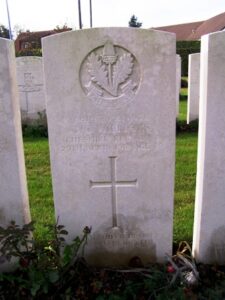
William Trevor Williams, Private, 936, Welsh Guards. William was the son of John Morris Williams and Mary Williams (nee Trevor). He was raised by his grandfather Griffith Trevor, at Waenfawr, Caernavon. William moved to Pantyffynon prior to the war, before enlisting at Swansea into the 1st Battalion, Welsh Guards. The Welsh Guards were formed early in 1915, becoming attached to 3 Guards Brigade, Guards Division. The Division was formed in France in August 1915, and saw its first major action during the Battle of Loos on 25 September, 1915, remaining in the area during the coming months, where they also fought in the subsequent Action of Hohenzollern Redoubt. The Guards Division then moved to the more peaceful (at the time) Ypres sector. William was killed just before the Guards moved to the Somme, while still at Ypres, on 16 July 1916, aged 20. He is buried at Brandhoek Military Cemetery, Belgium, in Grave II.J.9.
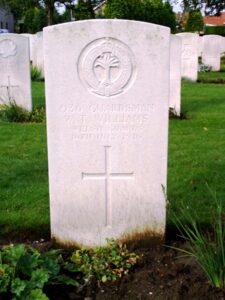
Edwin Frank Wood, Private, 67459, Cheshire Regiment. Edwin was the son of Robert and Mary Isabella Wood, of 41, Charles Street, Neyland, He had worked in the mines at Pantyffynon early in the war, living at 27, Mill Terrace, and enlisted at Llandeilo into the army on 11 July 1917. Edwin was posted to the 11th Battalion, Cheshire Regiment in April 1918. The battalion was attached to 75 Brigade, 25th Division, and had recently moved Ploegsteert. On 9 April 1918 the Germans launched an offensive on the Lys, and the Division was caught up in the terrible fighting here, at the Battles of Estaires, Bailleul, Messines and Kemmel. On 9 May the Division moved to Fismés, 20 miles SE of Soissons in the Champagne, to give it a chance to rest and rebuild again. However, on 26 May they took up positions south of the Aisne, to guard against a predicted German Offensive. On 27 May the attack hit them, and during the coming days the Division was virtually annihilated. Edwin was captured during this period, and was sent to a Prisoner of War Camp in Poland. Sadly he became ill and died there of meningitis on 4 November 1918 and is now buried at Poznan Old Garrison Cemetery, Poland. He was just 19 years old. Many thanks to Peter Bennett for the photograph.
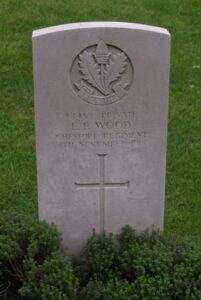
World War Two, 1939-1945
Phillip Allen, Private, 6851884, Middlesex Regiment. Phillip was the son of Abirthar and Selina Allen, of Tycroes. He served with the 2/7th Battalion, Middlesex Regiment, which was became the Divisional Machine-Gun Battalion to the 46th (North Midland) Division, before moving to North Africa, where it joined the 1st Division. The Division took part in the invasion of Sicily, and it was there that Phillip was killed on 20 July 1943, aged 31. Phillip is buried at Catania War Cemetery, Sicily, in Grave IV. K. 15.
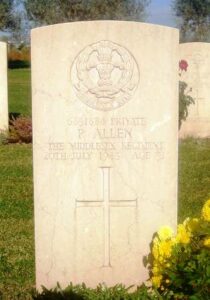
Francis Ashby, Sapper, 14248183, Royal Engineers. Francis was the son of William and Margaret Ashby, and the husband of Beatrice Mary Sophia Ashby, of Llandebie. He served in 857 Quarrying Company, Royal Engineers, and died at home on 4 December 1942, aged 25. Francis is buried at Llandebie (St. Tybie) Churchyard. Many thanks to Dave Hanson for the photograph.
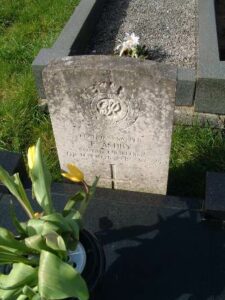
John Vincent Davies, Gunner, 1817055, Royal Artillery. John was the son of Rees and Blodwen Davies, of Llanedi. He served with 3 Battery, 6 Heavy Anti-Aircraft Regiment, Royal Artillery. The battery formed part of the Singapore coastal defences, but when Singapore surrendered to the Japanese in December 1941, John was taken POW. He was sent to Saigon in April 1942, with a party led by Lt/Col Hugonin, and was sent to Thailand in June 1943. John died at Kroeng Krai of tropical ulcers on 7 December 1943, aged 22. He was buried in Kroeng Krai cemetery, but after the war his grave was moved to Kanchanaburi War Cemetery, Thailand. John is not commemorated at Llanedi.
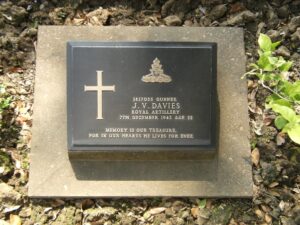
Roy Davies, Naval Airman 2nd Class, FAA/FX 78100, Royal Navy. Roy was born in Clapham on 23 June 1919. He was the Foster-son of Elizabeth Mary Davies, of Heol Brown, Tycroes. Roy worked as a Solicitor’s Clerk and had played rugby for Tycroes RFC prior to enlisting into the Royal Navy, and was posted to HMS Goshawk, the Royal Naval Air Station at Piarco, Trinidad, used for fighter training. He embarked at Liverpool aboard the Blue Star Liner SS Almeda Star, bound for the River Plate. On 17 January 1941, Almeda Star was torpedoed without warning by the German submarine U-96, and sank with the loss of 360 lives. Among the dead was Roy, who was just 21 years old. He has no known grave and is commemorated on the Lee-on-Solent Memorial, Hampshire.
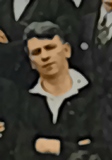
Vincent Howell Davies, Fusilier, 4198779, Royal Welch Fusiliers. Vincent was the son of Stephen and Sarah Davies, and served with the 1st Battalion, Royal Welch Fusiliers. In 1942 the Battalion sailed for the Far East, and arrived in India at the end of May 1942. They fought during the campaign in Burma against the Japanese, which is where Vincent was killed, during the Battle of Kohima, on 6th May 1944. He was 26 years old, and is remembered on the Rangoon Memorial, Myanmar.
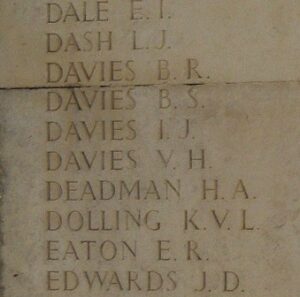
Roger Owen Francis, Sergeant (Wireless Op/ Air Gunner), 982893, Royal Air Force Volunteer Reserve. Roger was born early in 1921, the son of John and Elizabeth Francis (nee Rogers), of Llanedi. Roger served with 9 Squadron, RAFVR, which was a bomber squadron, equipped with the Vickers Wellington. At 22.05 hrs on the night of 10/11 April 1942, Roger took off aboard Wellington X3702 from RAF Honington, to bomb Essen, Germany. Soon after crossing into Germany, the aircraft was shot down and crashed at Himmelgeist on the east bank of the Rhine. All of the crew were killed, including Roger, who was 21 years old. The crew were buried side by side at Rheinberg War Cemetery, Germany.
Selwyn Griffiths, Petty Officer, D/JX 128350, Royal Navy. Selwyn was the son of Taliesin and Maud Griffiths of Pontardulais, and the husband of Doreen Griffiths, of Perranporth, Cornwall. He served in the Royal Navy aboard HMS Gloucester, which was a Town Class Cruiser, launched in 1937. She saw service in the Indian Ocean and around South Africa early in the war, before moving to the Mediterranean. Selwyn was killed when HMS Gloucester was sunk off Crete during the ill fated defence of the Island on 22 May 1941. He was 31 years old, and is commemorated on the Plymouth Naval Memorial, Devon. Over 700 men died in the loss of Gloucester.
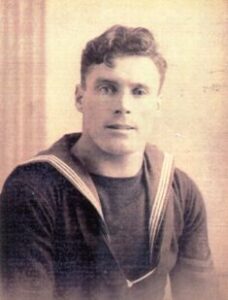
Kenneth Gwyn Hanham, Ordinary Seaman, Merchant Navy. Kenneth was born at Llanedi in 1922, the son of John Hanham and Elizabeth Hanham (nee Evans). He played rugby for Tycoes RFC prior to the war. Kenneth married Catherine Ann Llewelyn, of Glanamman, in 1941, just prior to enlisting into the Merchant Navy. He was posted aboard the SS Sourabaya, a Jersey registered converted whaling ship. She left New York on 18 October 1942, with a cargo of fuel oil, war stores, and 87 passengers, in Convoy HX-212. On 27 October 1942, South-East of Cape Farewell, U-436 fired a spread of three torpedoes into the convoy of which the third torpedo hit the Sourabaya sinking her. Kenneth died that day. He was 20 years old, and is commemorated on the Tower Hill Memorial, London. He was the holder of the King’s Commendation for Brave Conduct.
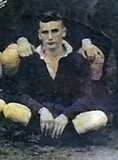
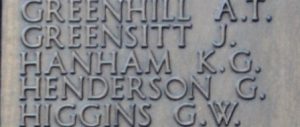
Gareth Alwyn Harries, Private, 14179344, Royal Army Ordnance Corps. Gareth was the son of William D. Harries and Sarah E. Harries, of Tycroes, and served with the 5th Ordnance Base Depot, Royal Army Ordnance Corps, which was based in North Africa. Gareth was too young to serve during World War Two, but was serving in Egypt when he died on 19 March 1947. He was 18 years old, and is buried at Tel El Kebir War Memorial Cemetery, Egypt, in Grave 5. G. 4.
David Rees Douglas Jenkins, Private, 14201507, Gordon Highlanders. David was the son of Thomas and Sarah Ann Jenkins, of Pantyffynnon, and served with the 1st Battalion, (The London Scottish), Gordon Highlanders. The Battalion were in France at the outbreak of war, and held St. Valery-en-Caux in an effort to buy time for the remainder of the BEF to be evacuated from Dunkirk. The entire Battalion was captured after the surrender of France, and a new 1st Battalion was raised in Scotland, and sent to the Middle East, landing at Tripoli. David was either wounded or taken ill in North Africa, as he was brought to Mosul in Iraq for treatment. He died there on 3 March 1943, aged just 21, and is buried at Mosul War Cemetery.
Robert Owen Johns, Private, 6400916, Royal Sussex Regiment. Robert was the son of Alphonso and Martha Johns, of Llanedi, and the husband of Nellie May Johns, of Haywards Heath, Sussex. He served with the 4th Battalion, Royal Sussex Regiment. The battalion saw heavy fighting during the retreat to Dunkirk, and was killed there at sometime between 29 May and 2 June 1940. He was 32 years old, and is commemorated on the Dunkirk Memorial, France. Robert is not commemorated at Llanedi.
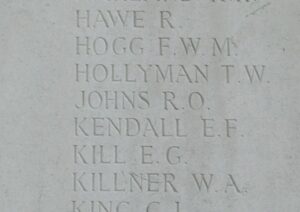
Hilton Jones, Flight Sergeant, 965692, Royal Air Force Volunteer Reserve. Hilton was the son of Mabel Jones, of Pontardulais, and he served with 220 Squadron, RAF. The Squadron flew with Coastal Command, equipped with the Hudson. In April 1941 the squadron as a whole moved to Wick in Scotland, where it continued to operate on anti shipping duties over Norwegian waters. Hilton was killed on 19 October 1941 when his Hudson did not return from a flight to Norway. He was 20 years old, and is commemorated on the Runnymede Memorial, Surrey.
Leonard Jones, Flight Sergeant (Air Gunner), 1837130, Royal Air Force Volunteer Reserve. Leonard was the son of Samuel and Bessie Jones, of Tycroes, and served with 149 Squadron, Royal Air Force, which was a heavy bomber unit, based at RAF Methswold, and equipped with the Avro Lancaster III. Leonard was killed on 5 June 1945, probably during a mission to drop food. He was 21 years old, and is buried at Lille Southern Cemetery, France.
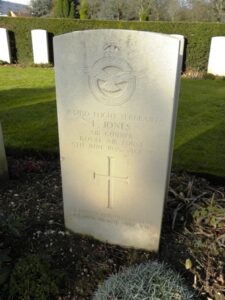
Richard James Mitchell, Lance Serjeant, 2734611, Royal Artillery. Richard was the son of Mary Mitchell, and the husband of Edith Gwendoline Mitchell, of Pontardulais. He served with 312 Battery, 90 Light Anti Aircraft Regiment, Royal Artillery. Richard served in North Africa, and took part in the invasion of Sicily and Italy in 1943-4. He was 25 years old when he was killed at Anzio on 12 February 1944, and is buried at Anzio War Cemetery, Italy.
John Morgan, Private, 3915890, South Wales Borderers. John lived at Iscoed Road, Hendy, Pontardulais. He served with the 6th Battalion, South Wales Borderers, which was raised in July 1940. The battalion sailed for Bombay in October 1942, and trained in India until March 1943, before moving to Calcutta. It was then posted to Burma, where it took part in a hard fought campaign against the Japanese, and the 6th SWB gained fame for their part in the capture of the Mayu Tunnels. In February 1945 the Battalion crossed the Irrawaddy, and took possession of Myitson, where three bridgeheads were developed. In the following days the Japanese launched a series of heavy attacks on the possession, but the SWB clung on. John was killed at Myitson on 16 February 1945. He was 22 years old, and is buried at Taukkyan War Cemetery, Myanmar.
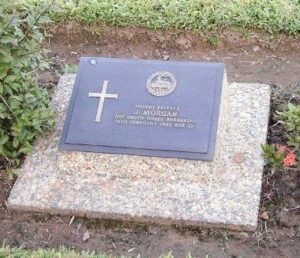
Lewis Winston Palmer, Leading Aircraftman, 1250436, Royal Air Force Volunteer Reserve. Lewis was the son of William and Mary Palmer. His brother George Palmer had been killed at Gallipoli in 1915. Very little can presently be found of Lewis’ wartime service, but he died at Bridgend on 26 December 1944, aged 39, and is buried at Llanedi (St. Edith) Churchyard. Many thanks to Bev Lewis for the photograph.
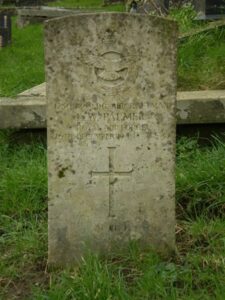
Benjamin Raymond Waters, Trooper, 7901572, Royal Armoured Corps. Benjamin served with the 3rd Kings Own Hussars, which was an armoured unit, attached to the Royal Armoured Corps. After the fall of France, the 3rd Hussars moved to North Africa, but in 1941 ‘B’ Squadron was sent to Singapore as reinforcements, before being diverted to Java after the surrender of Singapore. Benjamin was captured by the Japanese in Java, and was transported to Japan for labour. Benjamin died of colitis at Camp F4B at Moji on 18 December 1942, aged 23. He was cremated by the Japanese, and is commemorated on the Yokohama Cremation Memorial, Japan.
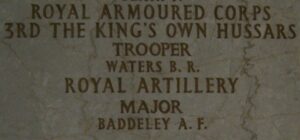
Johnny Waters, Marine, PLY/X 101624, Royal Marines. Johnny was born on 24 February 1914, the son of Lewis and Sarah Ann Waters, of Tycroes and was the husband of Jenny Waters, of Llanedi. He served in the Royal Marines and was posted to HMS Charybdis, a Dido Class Light Cruiser, launched in 1940. She had a busy career, serving in the Malta Convoys, at North Africa in 1942, Salerno in 1943, the Atlantic in 1943, then the English Channel and the Bay of Biscay during 1943. On 23 October 1943 she was heading a small force, which was tasked with the sinking of the German supply ship Munsterland, when she was sunk by a German Torpedo boat. Jonny was killed in the sinking. He was 29 years old, and was buried at St. Brieuc Western Communal Cemetery, France, after his body washed ashore.